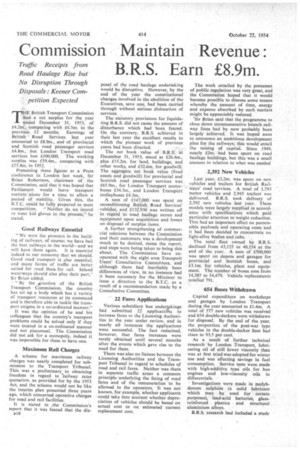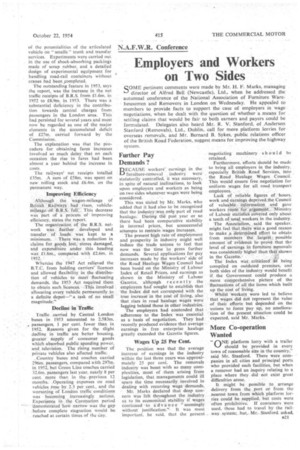Commission Maintain Revenue B.R.S. Earn £8.9m.
Page 52

Page 55

If you've noticed an error in this article please click here to report it so we can fix it.
Traffic Receipts from Road Haulage Rise but No Disruption Through Disposals-: Keener Com petition Expected
THE British Transport Commission had a net surplus for the year ended December 31, 1953, of £4.2m... comparing with £4.5m. in the previous 12 months. Earnings of British Road Services last year amounted to £8.9m., and of provincial and Scottish road passenger services £4.8m., but London Transport road services lost £100,000. The working surplus was £59.4m., comparing with
£55.8m. in 1952. .
Presenting these figures at a Press conference in London last week, Sir Brian Robertson, chairman of the Commission, said that it was hoped that Parliament would leave transport matters alone for a time to allow a period of stability. Given this, the B.T.C. could be fully prepared to meet competition. "Neither do we intend to wear kid gloves in the process," he stated.
Good Railways Essential "We were the pioneers in the building of railways, of course; we have had the best railways in the world—and we
will have them again. It is essential indeed to our economy that we should. Good road transport is also essential, and many forms of traffic are better suited for road than. for rail. Inland waterways should also play their part,' Sir Brian added.
" By the 4Freation of the British Transport Commission, the country has set up a body which has a variety of transport resources at its command and is therefore able to tackle the transport enigma in a co-ordinated manner."
It was the opinion of he and his colleagues that the country's transport problems could be solved only if they were treated in a co-ordinated manner and not piecemeal, The Commission did not ask for a monopoly, indeed it was impossible for them to have one.
Mayihnum Rail Charges .
A scheme for maximum railway charges was nearly completed for submission to the Transport Tribunal. This was a preliminary. to obtaining freedom in regard to to
quotation, as provided for by the 1953 Act, and the scheme would not be like the interim plan presented three years ago, which concerned operative charges for road and rail facilities.
It is stated in ,the Commission's report that it was feared that the dis posal of the road haulage undertaking would be disruptive. However, by the end of the year the constitutional changes involved in the abolition of the Executives, save one, had been carried through without serious dislocation of services.
The statutory provisions for liquidating B.R.S. did not cause the amount of disturbance which had been feared. On the contrary, B.R.S. achieved in their last year the excellent results to which the pioneer work of previous years had been directed.
The net book value of B.R.S. at December 31, 1953, stood at £26.4m., plus £15.2m. for land, buildings, and other works, and £32.6m. for goodwill. The aggregate net book value (fixed assets and goodwill) for provincial and Scottish road passenger services was £65.9m., for London Transport motorbuses £34.5m., and London Transport trolleybuses £4.3m.
A sum of £147,000 was spent on reconditioning British Road Services' • vehicles, and £131936 was written off in regard to road haulage stores and equipment upon acquisition and losses on disposal of surplus items.
A further strengthening of commercial relations between the Commission and their customers was a development much to be desired, states the report, and steps were being taken to bring this about. The Commission have cooperated with the eight area Transport Users' Consultative Committees, and although there had inevitably been differences of view, in no instance had it been necessary for the Minister to issue a direction to the B.T.C. as a result of a recommendation made by a Consultative Committee.
22 Fares Applications
Various subsidiary bus undertakings had . submitted 22 applicatiOfts to increase fares to the Licensing Authorities in the year under review, and in nearly all instances the appliFations were successful. The fact remained, however, that fares increases were rarely obtained until several months after the events which gave rise to the need for them.
There was also no liaison between the Licensing Authorities and the Transport Tribunal in regard to schedules of road and rail fares. Neither was there in separate traffic areas a common principle underlying the fixing of road fares and of the remuneration to be allowed to the operators. It was not known, for example, whether applicants could take into account whether depreciation of vehicles should be based on actual cost or on estimated current replacement cost. The work entailed by the processes of public regulation was very great, and the Commission hoped that it would become possible to discuss some means whereby the amount of time, energy and expense absorbed by such matters might be appreciably reduced.
'Sir Brian said that the programme to close down unremunerative branch railway lines had by now probably been largely achieved. It was hoped soon to announce an ambitious development plan for the railways; this would entail the raising of capital. Since 1949, nearly £2m. had been spent on road haulage buildings, but this was a small amount in relation to what was needed
2,392 New Vehicles
Last year, £2.2m. was spent on new vehicles and trailers for British Railways' road 'services. A total of 1,793 motor vehicles and 2,945 trailed was delivered. B.R.S. took delivery of 2.392 new vehicles last year. These models were largely supplied in accordance with specifications which paid particular attention to weight reduction. This had an important effect on permissible payloads and operating costs and it had been decided to concentrate on light-alloy bodies and cabs. " The total fleet owned by B.R.S. declined from 43,125 to 40,154 at the end of the year. A sum of £500,000 was spent on depots and garages for provincial and Scottish buses, and £3.1m. for vehicles, plant and equipment. The number of buses rose from 14,385 to 14,479. Vehicle replacements totalled 791.
654 Buses Withdrawn
Capital expenditure on workshops and garages by London Transport during the year amounted to £1.4m. A total of 577 new vehicles was received and 654 double-deckers were withdrawn for disposal. By the end of the year, the proportion of the post-war type vehicles in the double-decker fleet had risen to 93.5 per cent.
As a result of further technical research by London Transport, lubricating oil of still lower viscosity than was at first tried was adopted for winter use and was effecting savings in fuel consumption. Service tests were made with high-additive type oils for bus engines and low-viscosity oils in differentials.
Investigations were made in molybdenum sulphide (a solid lubricant which may be used for certain purposes), lead-acid batteries, glass, reinforced plastics and structural aluminium alloys.
B.R.S. research had included a study of the potentialities of the articulated vehicle on " smalls " trunk and transfer services. Experiments were carried out in the use of shock-absorbing packings made of scrap rubber, and a detailed design of experimental equipment for handling road-rail containers without cranes had been _completed.
The outstanding feature in 1953, says the report, was the increase in the net traffic receipts of B.R.S. from £1.6m. in 1952 to £8.9m. in 1953. There was a substantial deficiency in the contribution towards central charges from passengers in the London area. This had persisted for several years and must now be regarded as one of the major elements in the accumulated deficit of £27m. carried forward by the Commission.
The explanation was that the procedure for obtaining fares increases involved so much delay that on each occasion the rise in fares had been almost a year behind the increase in costs,
The railways' net receipts totalled £35m. A sum of £58m. was spent on new rolling stock and £6.4m, on the permanent way.
Improving Efficiency
Although the wagon-mileage of British Railways had risen, vehiclemileage of R.R.S. fell. This decrease was part of a process of' improving efficiency, states the report.
The organization of the B.R.S. network was further developed and transfer of loads was kept to a minimum. There was a reduction in claims for goods lost; stores damaged, and expenditure under this heading was £1.6m., compared with £2.6m. in 1952.
Whereas the 1947 Act relieved the B.T.C. from holding carriers' licences and allowed flexibility in the distribution of vehicles to meet fluctuating demands, the 1953 Act required them to obtain such licences. This involved allocating every vehicle permanently to a definite depot—" a task of no small magnitude."
Decline in Traffic
Traffic carried by Central Londonbuses in 1953 amounted to 2,583m. . passengers. 1 per cent. fewer than in 1952. Reasons given for the Slight decline in traffic are better housing, greater supply of consumer goods which absorbed public spending power, and television. The rising number of private vehicles also affected traffic.
Country buses and coaches carried 296m. passengers, compared with 297m. in 1952, but Green Line coaches carried 32.6m. passengers last year, nearly 8 per cent. more than in the. previous 12 months. Operating expenses on road vehicles rose by 2.3 per cent., and the worsening of London traffic conditions was becoming increasingly serious. Experience in the Coronation period 'demonstrated how narrow was the gapbefore complete stagnation would be reached at certain times of the day.




































































































